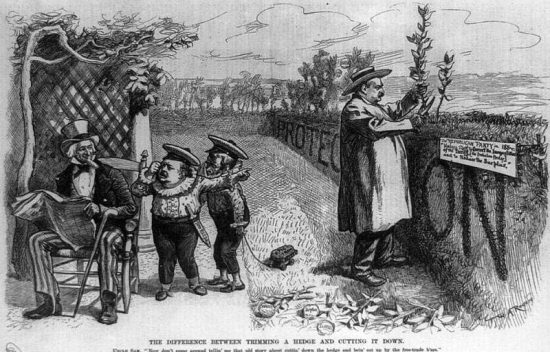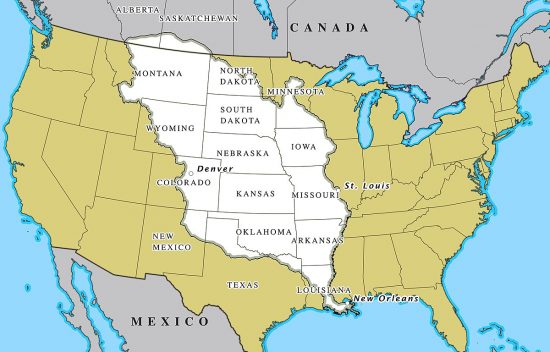Presidents and the Constitution
How is this resource organized?
- Volume I features fifteen lessons organized according to five constitutional themes: “The President and Federal Power;” “War and the Constitution,” “Slavery and the Constitution,” “The President as Chief Diplomat,” and “Electing the President.”
- Volume II features three new themes and additional lessons on “The President and Federal Power” and “War and the Constitution.”
- Each theme begins with a scholarly essay, discussing the constitutional theme and placing the issues in their historical context. Following the essay is a primary source analysis, called “Constitutional Connection”, which can serve as an introductory activity for the lessons in the theme.
- Each them contains three individual lessons on three Presidents.
- Lessons can be approached and presented individually, historically, or thematically. Each lesson includes a historical narrative about the featured President, focusing on the constitutional issues during their tenure in office.
- Lessons are modular and include warm-up activities, primary source analyses, simulations, guided controversies, role-plays, and other hands-on activities.
Want to create your own playlists, save resources to your library, and access answer keys? Sign up for an educator account!
5 Videos
 Video
VideoChief Diplomat: Presidents and the Constitution
The Constitution's principle of separation of powers is reflected in the President's power to make treaties with the advice and consent of the Senate. The Constitution goes on to require that two-thirds of Senators present must approve a treaty before it can be ratified. As "Chief Diplomat" for the nation, the President represents the United States to other countries, and directs our foreign policy. Various Presidents in our history have approached the concept of "advice and consent" differently, and have had varying degrees of success at persuading Senators of the wisdom of the treaties they have negotiated. George Washington was aware that his actions would set a precedent as to the meaning of the term "advice and consent." Many of his decisions with respect to Jay's Treaty also helped clearly define the separation of powers. Woodrow Wilson all but rejected the Senate's advice of the Treaty of Versailles, and for the first time in American history, the Senate rejected a peace treaty. Perhaps learning from history, Jimmy Carter took a different and more accommodating approach, winning ratification of the initially unpopular Panama Canal Treaties.
 Video
VideoSlavery: Presidents and the Constitution
Slavery: At the Constitutional Convention, the delegates were concerned with the survival of the young nation. Many delegates called for strong protections for slavery, while many others hated the idea of putting into the Constitution the idea that there could be property in people. With the goal of forming a Union, they reached a compromise. Slave states would count 3/5ths of their slave populations towards their state populations to calculate taxation and representation in Congress. This is known as the 3/5 Compromise. Additionally, Congress could not outlaw the international slave trade until 1808. The debate over the federal government's power to regulate slavery continued through the Civil War. James Buchanan, Abraham Lincoln, and Andrew Johnson, who served as President of the United States in the years immediately before, during, and after the Civil War, each had different approaches to the constitutional powers of the President, if any, to interfere with the spread of slavery. At the end of the Civil War, the Reconstruction Amendments, the 13th Amendment, 14th Amendment, and 15th Amendment, were added to the US Constitution. The three amendments abolished slavery, granted citizenship regardless of race, and allowed Black men the right to vote.
 Video
VideoElection: Presidents and the Constitution
Let’s Talk Elections! While many Americans believe they have a right to vote for President of the United States, they actually never cast votes for candidates themselves. Now, Americans vote for electors who, in modern times, are pledged to vote for certain candidates also known as the Electoral College. Why was the Electoral College created? The Founders imagined a republican system for citizens to vote for individuals in their state who they believed were wise and prudent (electors). How does the Electoral College work? The U.S. Constitution maps the Electoral College as electors, chosen by the people, would then themselves vote among candidates for President on behalf of their state. Despite recurrent calls for its abolition, the Electoral College has served and continues to serve as a means for presidential selection that represents the will of the people as well as the sovereignty of states. What happens if the electoral college is tied? Several times in our history, the Electoral College system was challenged as a result of unanticipated tie votes (1800), the allegation of a "corrupt bargain" among members of the House of Representatives (1826), and even conflicting sets of electoral votes submitted by states (1876). The Presidential election of 2000 was one of the most hotly contested in American history and ended with a Supreme Court decision halting the state-wide manual recount ordered by a state Supreme Court.
 Video
VideoFederal Power: Presidents and the Constitution
Debate about the limits of the president's power began at the Constitutional Convention and continues today. James Madison, considered the "Father of the Constitution," believed that strict limits on federal power were best for liberty. Powers of the federal government which were not enumerated in the Constitution were forbidden. Many later Presidents agreed with Madison, while others, beginning with Theodore Roosevelt, took a more expansive view of the scope of federal power. Theodore Roosevelt was the first President to argue that powers not forbidden were granted. He presided over the greatest expansion of federal power in our nation's history to that time. While the President has the power to "recommend measures" to Congress which he believed are necessary, the President is not a lawmaker. Franklin D. Roosevelt and Lyndon B. Johnson, capitalizing on what Theodore Roosevelt had called the "bully pulpit," were open advocates of policies they believed were needed, and which also increased the size and power of the central government. Ronald Reagan worked decrease the side of the national government and restore what he saw as the rightful place of states in our federal system. Tension between these two understandings (expressed powers and implied powers), and debate over the outcomes of their exercise, has persisted throughout American history.
 Video
VideoWar: Presidents and the Constitution
Commander in Chief: The US Constitution’s separation of powers allows Congress the power to declare war, raise and provide for the armed forces, as well as other war powers. However, the President serves as Commander in Chief of the United States military. The Founders' commitment to civilian control of the military is evident in this decision. They believed that the collective wisdom of Congress would be put to good use in determining whether to declare war, but that once declared, one individual would best be able to wage war. The extent of executive power has been debated over the years. Do these powers apply anywhere other than military situations? Does the President's role as Commander in Chief empower him to act in ways that may abridge the rights citizens who are not members of the military? John Adams and Woodrow Wilson, who signed the Alien and Sedition Acts of 1798 and Espionage Act of 1917, respectively, into law, were accused of enforcing unconstitutional restrictions on freedoms of speech and press. Abraham Lincoln, who led the nation through Civil War, was accused of numerous civil rights violations, including what many believed was an unconstitutional suspension of habeas corpus. In 1973, the War Powers Resolution was enacted to limit the President’s power to commit U.S. military forces abroad.
2 Units
 Unit
UnitPresidents and the Constitution Volume 1
Presidents and the Constitution will help you engage your students in this debate by analyzing the actions of Presidents in light of the Constitution.
 Unit
UnitPresidents and the Constitution Volume 2
Presidents and the Constitution will help you engage your students in this debate by analyzing the actions of Presidents in light of the Constitution.
40 Lessons
 Lesson
LessonAbraham Lincoln and Habeas Corpus
The “Great Writ” or habeas corpus has been an essential civil liberty guaranteed since Magna Carta. In listing powers denied to Congress, the Constitution notes that “The privilege of the writ of habeas corpus shall not be suspended, unless when in cases of rebellion or invasion the public safety may require it.” In 1861, Abraham Lincoln invoked this power of Congress—which was not in session—to suspend habeas corpus in certain areas. The next year, as he believed the civil justice system was inadequate to deal with the rebellion, he expanded the suspension throughout the United States and established military tribunals to try citizens charged with disloyalty. In this lesson, students explore Lincoln’s suspension of habeas corpus and constitutional issues surrounding it.
 Lesson
LessonAbraham Lincoln and the Emancipation Proclamation
Presidents Buchanan, Lincoln, and Johnson believed that the Constitution protected the institution of slavery. Lincoln came to the conclusion that, in order to preserve the Constitution and the Union it created, he must apply a new understanding of the principles on which the nation was built. The time had come to bring the nation’s policies in line with the of the Declaration of Independence that “…all men are created equal…” In this lesson, students will analyze Abraham Lincoln’s views on slavery and the Constitution as evidenced in the Emancipation Proclamation.
 Lesson
LessonAndrew Jackson and Indian Removal
Andrew Jackson pursued a policy of removing Native Americans from lands in the east to new territories west of the Mississippi. Removal was popular, as it would result in the opening of hundreds of thousands of acres to white settlement and gold mining. Jackson signed the Indian Removal Act, a federal law that empowered the President to negotiate treaties with Indian tribes with the goal of moving them west. Legislation designed to force Native Americans out was also passed at the state level. When Georgia ignored an 1831 Supreme Court ruling that state laws had no force against Indian tribes, Jackson turned a blind eye. Neither Jackson nor the US Senate listened when the Cherokee objected that the Treaty of New Echota was fraudulent. Jackson’s decisions regarding the enforcement of removal laws against Native Americans set the stage for the Trail of Tears, one of the most dishonorable events in American history.
 Lesson
LessonAndrew Johnson and the Civil War Amendments
President Andrew Johnson saw himself as a protector of the United States Constitution during and after the Civil War. In his efforts to preserve and restore the Union, he supported the Thirteenth Amendment ending slavery. The same motive led him to oppose the Fourteenth Amendment because he believed it would infringe on the legitimate powers of the states. In this lesson, students analyze Johnson’s leadership with respect to Reconstruction, and specifically his response to the passage of the Thirteenth and Fourteenth Amendments.
 Lesson
LessonConstitutional Connection: Electing the President
How the Constitution talk about presidential elections?
 Lesson
LessonConstitutional Connection: Impeachment and the Constitution
This lesson allows students to analyze the Constitution and ask questions about how the Constitution allows for impeachment of the President.
 Lesson
LessonConstitutional Connection: Presidents and the Transfer of Power
This lesson allows students to analyze the Constitution and ask questions about how the Constitution effects the transfer of power between presidents.
 Lesson
LessonConstitutional Connection: Slavery and the Constitution
This lesson allows students to analyze the Constitution and ask questions about how the Constitution relates to the institution of slavery.
































